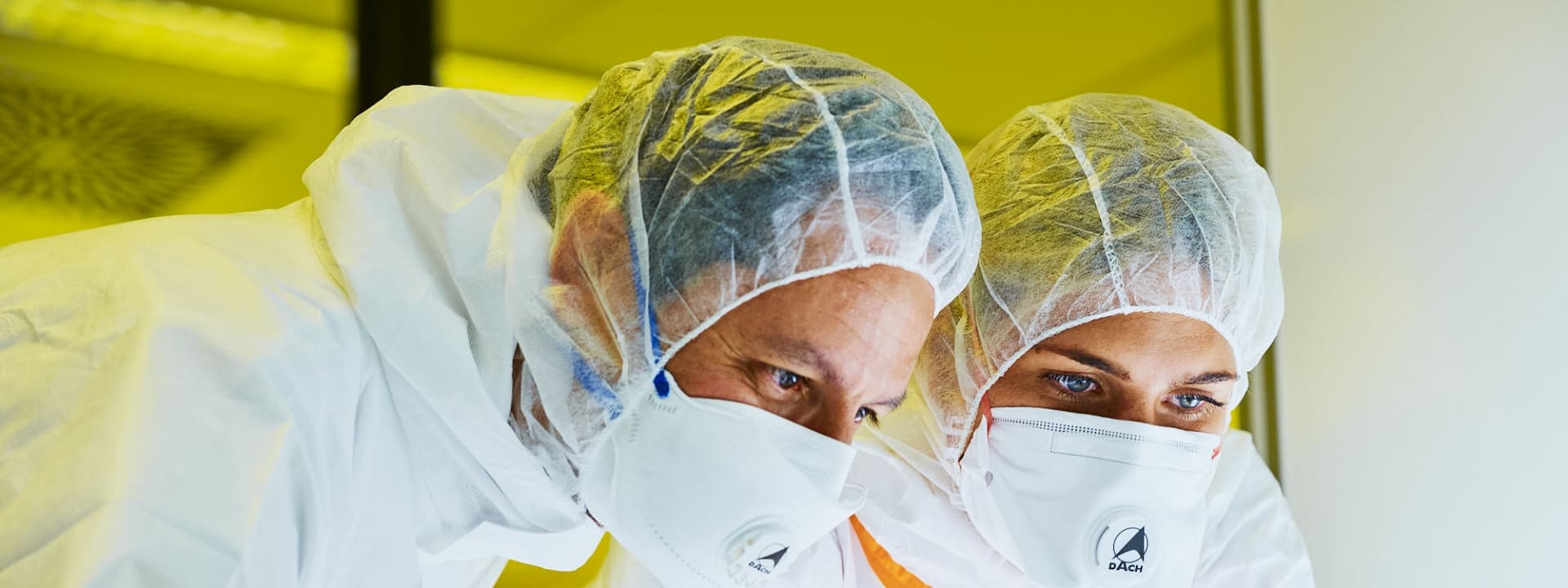Respirator selection guide: Which FPP protection class for which pollutant?
- Sommeraktion
- Branches
- Clean Room
- Information
- Products
- Respirators
| Pollutant | Filter class |
| Acrylamide | P3 |
| Aluminium, -oxide | P2 |
| Aluminium chloride, -oxide fume | P2/P3 |
| Ammonium chloride | P2 |
| Antimony | P3 |
| Arsenious acid | P3 |
| Arsenic trioxide (arsenic) | P3 |
| Asbestos | P2 |
| Asbestos from 50,000 fibres per m³ | P3 |
| Ash | P2 |
| Acid alkali | P2 |
| Bacteria (risk group 2) | P2 |
| Barium compounds, soluble, | P2 |
| Cotton dust | P2 |
| Benzo(a)pyrene -coking plants | P3 |
| Benzoic acid | P2 |
| Beryllium | P3 |
| Concrete | P2 |
| Biqhenyl | P3 |
| Lead and compounds | P3 |
| Lead chromate, -fume | P3 |
| Boron oxide - boric acid | P3 |
| Cadmium and compounds | P3 |
| Calcium hydroxide, oxide | P2 |
| Calcium sulphate | P2 |
| Carbon fibres | P2 |
| Chromium(VI) compounds | P3 |
| Cobalt metal, oxide, sulphide | P3 |
| Cyanides (e.g. cyanide...) | P2 |
| Diesel engine emissions | P3 |
| Diisocyanates (TDI, MDI, HDI) | P3 |
| Stainless steel (smoke, fine dust) | P3 |
| Iron oxides | P2 |
| Enzymes | P3 |
| Colour/varnish | P2 |
| Colour/varnish with chromates | P3 |
| Fluorides | P2 |
| Gypsum (calcium sulphate) | P2 |
| Glass fibres/mineral wool | P2 |
| Graphite | P2 |
| Hexachlorocyclohexane | P2 |
| Wood dust | P2 |
| Insecticides | P3 |
| Isocyanates see Diisocyanates | P3 |
| Iodine | P2 |
| Potassium hydroxide, caustic potash solution | P2 |
| Lime -burnt | P2 |
| Silica glass, -good, -gur, -smoke, -acid | .P2 |
| Cooling lubricants | P2 |
| Copper, -fume | P2 |
| Soldering fumes | P2 |
| Magnesium oxide | P2 |
| Marble | P2 |
| Masonry | P2 |
| Flour dust | P1 |
| Molybdenum compounds, soluble | P2 |
| Waste sorting | P3 |
| Naphthalene | P3 |
| Sodium azide | P2 |
| Sodium hydroxide, caustic soda | P2 |
| Nickel metal, oxide, sulphide | P3 |
| Parathion (E605) | P3 |
| Pesticide | P2 |
| Phenylhydrazine | P3 |
| Fungal spores | P2 |
| Platinum | P3 |
| Pollen | P2 |
| Polychlorinated biphenyls (PCBs) | P3 |
| Polyvinyl chloride (PVC) | P2 |
| Quartz | P3 |
| Quartz-containing particulate matter | P3 |
| Smoke | P2 |
| Rust | P2 |
| Rust protection coating | P2 |
| Rust protection coating with chromates | P3 |
| Soot | P2 |
| Salts of arsenious acid | P3 |
| Sulphuric acid | P2/P3 |
| Welding fumes in general | P2 |
| Silver and compounds (sol.) | P3 |
| Silicon carbide | P2 |
| Filler | P1 |
| Steel | P2 |
| Steel, high-alloy | P3 |
| Steel anti-fouling paints | P3 |
| Stone dust | P1 |
| Stone dust, containing quartz | P2 |
| Synthetic mineral fibres | P3 |
| Tobacco smoke | P3 |
| Tobacco dust | P2 |
| Talk | P2 |
| Titanium oxide | P2 |
| Tributyl tin compound. (TBTO) | P3 |
| Uranium compounds | P3 |
| Vanadium pentoxide | P3 |
| Viruses/bacteria (risk group 3) | P3 |
| Cement | P2 |
| Zinc oxide smoke | P2 |
| Tin compounds, inorganic/organic | P3 |
| Cytostatic agents | P3 |
The selection guide is intended as an aid only. It is the responsibility of the user to check precisely whether a respirator meets the requirements regarding hazardous substances and their concentration in the specific application. DACH Schutzbekleidung does not accept any obligations or liabilities in connection with this selection guide.





.jpg)

.jpg)
.jpg)


